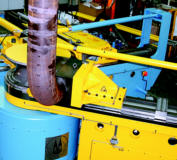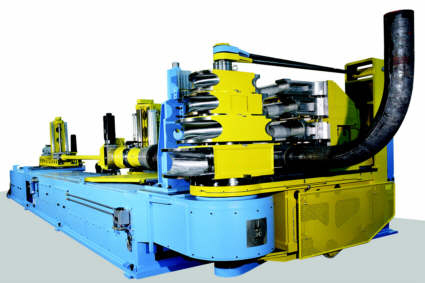|
Pipe Cold Bending Machines from
Schwarze-Robitec
Bending the Costs Downward
Bert Zorn, Managing Director of Schwarze-Robitec, on the possibilities of
pipe bending in plant and pipeline construction
Dec 02, 2014 + + +
There are many kilometres of pipe on oil platforms, complex chemical
plants, refineries and large power stations. All feature similarly large
stretches of pipeline. In view of these quantities, pipe fitting plays a
special role in plant and pipeline construction; the conduit system must
be installed quickly and efficiently. Moreover, these constructions are
essential for the function and efficiency of the plants.
 For an oil
platform or refinery, hundreds of kilometres of pipes are installed –
including countless pipe bends. Great cost savings can be
achieved
with pre-bent pipelines. For an oil
platform or refinery, hundreds of kilometres of pipes are installed –
including countless pipe bends. Great cost savings can be
achieved
with pre-bent pipelines.
Expensive welding and checking processes are no longer required.
Challenges of pipe
bending
A cursory glance at an oil pumping facility
clearly shows the central challenge: The pipes form a highly complex
network and the conduit system inevitably includes many bends. As such, a
large number of different formed pipe bends in a variety of dimensions,
forms and angles are used in the piping installation. These components
need to be welded to the straight, long pipes on the construction site to
form the desired pipeline. As a result, these processes represent
considerable costs in the construction of these plants. First, the curved
elements must be produced in advance, is some cases at an off-site
facility. Second, these components must be transported to the work-area
and welded to the corresponding pipes, including the associated cost of
logistics that can generate additional costs. Additionally, it is often
vital to check every finished weld joint for compliance to industry
standards or special customer requirements. The processes of using
ultrasound or x-ray technology to inspect the welds can also cost a great
deal of time and money. It becomes clear that the many pipe bends and the
processes involved to produce a complete assembly can offer a tremendous
potential for savings in plant construction – if ultimately, many of the
in-situ welded bends could be replaced by pre-bent pipelines that are able
to be fabricated to the exact specifications of the construction site. In
order to meet these production requirements, there are essentially two
options: Cold and warm bending. With warm bending, the pipe is initially
partially heated at the desired bend location. Through the factors of
temperature and pressure, the material begins to flow. The disadvantages
of the warm bending process are that it takes a long time to form the
material and the energy consumption used in the production process is very
high.
  
Picture 1: Modern Controls make operation of
the production facilities easier. They can be programmed as desired ...
Picture 2: The machines allow bending radii that are only slightly larger
than the pipe diameter ... Picture 3: The CNC 320 HD pipe cold
bending machine can process steel pipes with a maximum external diameter
of 323.9 mm and a maximum wall thickness of 17.5 mm
Challenges of pipe
bending
A cursory glance at an oil pumping facility
clearly shows the central challenge: The pipes form a highly complex
network and the conduit system inevitably includes many bends. As such, a
large number of different formed pipe bends in a variety of dimensions,
forms and angles are used in the piping installation. These components
need to be welded to the straight, long pipes on the construction site to
form the desired pipeline. As a result, these processes represent
considerable costs in the construction of these plants. First, the curved
elements must be produced in advance, is some cases at an off-site
facility. Second, these components must be transported to the work-area
and welded to the corresponding pipes, including the associated cost of
logistics that can generate additional costs. Additionally, it is often
vital to check every finished weld joint for compliance to industry
standards or special customer requirements. The processes of using
ultrasound or x-ray technology to inspect the welds can also cost a great
deal of time and money. It becomes clear that the many pipe bends and the
processes involved to produce a complete assembly can offer a tremendous
potential for savings in plant construction – if ultimately, many of the
in-situ welded bends could be replaced by pre-bent pipelines that are able
to be fabricated to the exact specifications of the construction site. In
order to meet these production requirements, there are essentially two
options: Cold and warm bending. With warm bending, the pipe is initially
partially heated at the desired bend location. Through the factors of
temperature and pressure, the material begins to flow. The disadvantages
of the warm bending process are that it takes a long time to form the
material and the energy consumption used in the production process is very
high.
Time and Cost Advantages of Cold Bending
In comparison to the option of warm bending,
cold bending offers several advantages, because this procedure eliminates
the energy-intensive and protracted heating process. Only the properties
of the material are what set certain limits to the plasticity. Otherwise,
the pipe can be shaped into almost any form. For example, with the CNC 320
HD bending machine from Schwarze-Robitec, the cold bending of a pipe with
a nominal diameter of 12” NPS takes only around one minute – in contrast
to the 30 minutes at least that would be needed for the warm bending
process. In addition, there are other advantages. For example: With cold
bending, materials can be processed that cannot be bent warm or for which
heating is simply not permitted because it changes the microstructure of
the material. As a result, cold bending has therefore only two real
constraints: The space available in the workshop and the length of the
machine. If during the bending process the long pipes do not axially
collide, they can be processed into complex shapes directly in one pass.
Additional positive points of the cold bending process are: The pipe is
clamped in an index head and held in place by means of a collet in the
transport unit and index head. After the first bend, it is directly
transported forward and rotated as required. As a result, three
dimensional pipe systems can be created very quickly without a single weld
joint.
When the bending
radius is critical
What is particularly important in plant
construction is the achievable bending radius of the pipe – and it is
precisely in this area that the mechanical engineers from Schwarze-Robitec
have exceptional experience. The machines allow bending of pipe with very
small radii, even when the pipes are very large and thick-walled. What
does this mean in regards to plant construction and why is this
characteristic so important? The critical advantage of the ability to
produce a small radius becomes apparent when installing the pipe: the
tighter the bend of the pipe, the less installation space is required –
ultimately, the entire pipe system or platform requires less floor area.
Moreover, a great deal of pipe can be saved with a small bending radius.
The saving with a 180-degree bend and a bending radius of 1.5x D is around
3.5 metres compared with a conventional 5x D bend – on larger production
facilities, this small value naturally offers a huge effect on cost
reduction. Only recently, the German mechanical builders constructed and
delivered a machine to a customer in the refinery and offshore oil
industry. The machine is able to process pipes up to 16” NPS with a radius
of 1.5x D. As a result, a 16” Schedule 40 (323.5 by 10 millimetres) pipe,
for example, can be bent with a radius diameter of only 485 millimetres –
all of course in observance of the required standards (for example in
respect to reduction of the wall thickness and ovality).
Focus on quality
The technology developed by Schwarze-Robitec is
always based on a very rugged machine frame. It reliably resists the huge
forces that arise during bending and has abundant power reserves for the
clamping functions. In addition, the issue of quality control is
particularly important for the specialists at Schwarze-Robitec. For
example, the SpringMatic system can measure the pipe bend while still in
the bending machine and correct its curvature as necessary. The measuring
and correction process takes only a few seconds. As a result, even pipes
with unknown properties or widely fluctuating quality can be processed
directly with a high level of accuracy. The machines in the CNC-MW series
from Schwarze-Robitec also ensure additional productivity in the bending
process. The reason for this is that setup times are minimal. To achieve
this, the production facilities use stacked tooling with various nominal
diameters constructed one above the other. If a new batch of pipes with a
different nominal diameters are used in the production sequence then only
the bending mandrel and collet insert need to be changed. This process
takes only a few minutes. Consequently, the current bending process is
able to continue with unchanged speed and accuracy. Likewise, the
processing of flanged pipes is unproblematic. Even before bending, the
flanges or sleeves can be welded on. The sophisticated control of the
machine and its stable structure ensure accuracy. The stable structure of
the machine prevents twisting and the pipe therefore going out of
specification, or the flanges ending up at the wrong angle.
Complete know-how
Naturally, the structure of these specialised
machines is heavily dependent on the specific requirements of the
customer. Schwarze-Robitec therefore supplies customised solutions. An
important criterion in the construction of the machine is also the energy
efficiency of the production facility. At the same time, the experts at
Schwarze-Robitec have a wealth of practical experience with the different
pipe materials and as a result, with the corresponding tool and machine
requirements. With this complete know-how, Schwarze-Robitec develops
answers for the most difficult production jobs. As such, the experts have
previously constructed production facilities with a pipe length of over 40
metres and integrated high-rack pipe storage into the automatic pipe feed
to the bending machine. Of course, the machines and their control have the
latest EDP networking, quality control functions and simulation
technology. Not be underestimated is the advantage that is closely bound
to the promise “Made in Germany”: the reliability of the production
facilities. In recent decades, Schwarze-Robitec has delivered over 2500
cold bending machines to customers on all continents. Many machines
supplied thirty or more years ago are still in use today. Here,
Schwarze-Robitec guarantees spare parts availability over many years; for
the entire operating life of the machines. In addition, international
customer service is available – for maintenance on-site or for the
optimisation of production processes. Bending complex pipelines quickly
and accurately which results in saving considerable time and expense with
installation – these are the central advantages of the Schwarze-Robitec
technology. In view of increasing international energy demand and the
associated investments in an efficient, state-of-the-art manufacturer
infrastructure, the German mechanical engineers are expecting great market
opportunities for their bending solutions.
The bending tool
The experts from Schwarze-Robitec construct
tooling and stacked bending tooling that are designed perfectly for the
respective application. For special applications, the tools have
automation components, which allow “bend in bend” processes, which can be
preheated or can process special materials. The outstanding quality and
precision in bending is ensured by a sophisticated structure comprising
bend former, clamp jaw (for clamping the pipe), pressure die (as a
counterbearing for the bending moment to be applied) and possibly a
bending mandrel and wiper die
|
Technical specifications of the CNC 320 HD pipe
cold bending machine
Max. capacity of the machine:
External pipe Ø x wall thickness
Standard steel: 323.9 x 17.5 mm
Stainless steel: 323.9 x 8.8 mm
Max. moment of resistance: Approx. 1225 cm³
Max. bending radius to pipe centre: As desired
by the customer
Max. pipe length: 6000 mm
Max. bending angle: 180° + deflection
Max. bending angle accuracy: ± 0.1°
All values correspond to the standard
configuration and can be adjusted according to the wishes of the customer.
|
+ + +
About Schwarze-Robitec GmbH
The CompanyHaving been founded in 1903, Schwarze-Robitec
is among the international leading experts in the area of tube bending
machines. Since 2011, the company has been run by Managing Directors Bert
Zorn and Hartmut Stöhr. At the head office in Cologne, the cold-bending
machine specialist currently employs 130 staff. The company is represented
worldwide through long-standing partners. As early as in 1977,
Schwarze-Robitec produced the world’s first CNC tube bending machine. Over
2,400 machines have been sold to date, many of which have been in
unrestricted use in production for over 35 years. In addition to tube
bending machines and bending tools, the range supplied by Schwarze-Robitec
also includes tube perforating machines, measuring systems and solutions
in special engineering. Without exception, the Schwarze-Robitec list of
references includes all of the prestigious manufacturers from the
automotive industry, energy sector and shipbuilding. Furthermore, the
company’s solutions are used in aerospace and many other industries.
Source: Bert Zorn, Schwarze-Robitec GmbH
www.schwarze-robitec.com
|

Worldwide more than
90,000 paid subscriptions

Worldwide
more than 48,000 subscriptions -
100% one-year direct request
qualification

'What's New' in Upstream, Midstream and
Downstream Products & Services. Circulation 37,000
PennWell
Petroleum Group:
Oil & Gas Journal
Oil & Gas Journal Russia
OGJ_eNewsletter
OGJ-Website-Statistics
Oil, Gas & Petrochem Equipment
Offshore Magazine
Offshore
Russia
Offshore eNewsletter
Offshore
Website Statistics
Oil & Gas Financial Journal
+ + +
For more information, media
kits or
sample copies please contact
Andreas
Sicking
+49 (0)2903-338570
wilhelms@pennwell.com
www.sicking.de
|

 For an oil
platform or refinery, hundreds of kilometres of pipes are installed –
including countless pipe bends. Great cost savings can be
For an oil
platform or refinery, hundreds of kilometres of pipes are installed –
including countless pipe bends. Great cost savings can be 



